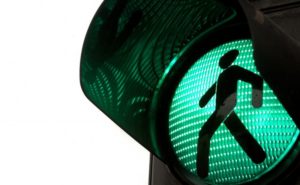A team of researchers at Carnegie Mellon University has developed a footstep monitoring system that can be used to identify people based on their movement patterns as they walk across a room. The system utilizes cylindrical sensors to measure the vibrations caused by footfalls and other movements.

The sensors themselves are a few centimeters high, and can be placed on the floor at intervals of 20 meters to turn any surface into a biometric monitoring platform.
“We call this ‘structures as sensors,’” explained researcher Hae Young Noh, who is now at Stanford. “We’re using these big physical structures like buildings and bridges as a sensing system to indirectly monitor humans and surrounding environments.”
The software in the system is sophisticated enough to filter out background noise, and automatically adjusts its sensitivity level based on the proximity of the individual. It takes advantage of the fact that everyone has a unique gait to identify and track people as they move around. The result is essentially a real-life version of Harry Potter’s Marauder’s Map, in the sense that it can accurately locate every individual in a designated area in real time.
Of course, that kind of technology raises obvious privacy concerns, which is why the researchers are hoping that it will be used primarily for opt-in healthcare applications. If someone changes their gait, it can be evidence of an underlying medical condition. That could make the sensors an appealing home monitoring solution for people with chronic conditions or the elderly. The system is less intrusive than wearables and other on-body sensors, and offers more privacy than cameras that record video footage of a personal space.
The technology can also facilitate the early diagnosis of some conditions. The sensors only cost $10 to $20 and do not require the installation of any special mats or flooring, which distinguishes the system from many of the other gait recognition solutions that are currently in development.
The Carnegie Mellon system can identify people with 95 percent accuracy. Mastercard recently explored the possibility of using gait recognition as an alternative payment system for transit fares, although that system would use cameras to record people’s movements.
Source: Scientific American
–
April 30, 2020 – by Eric Weiss







Follow Us